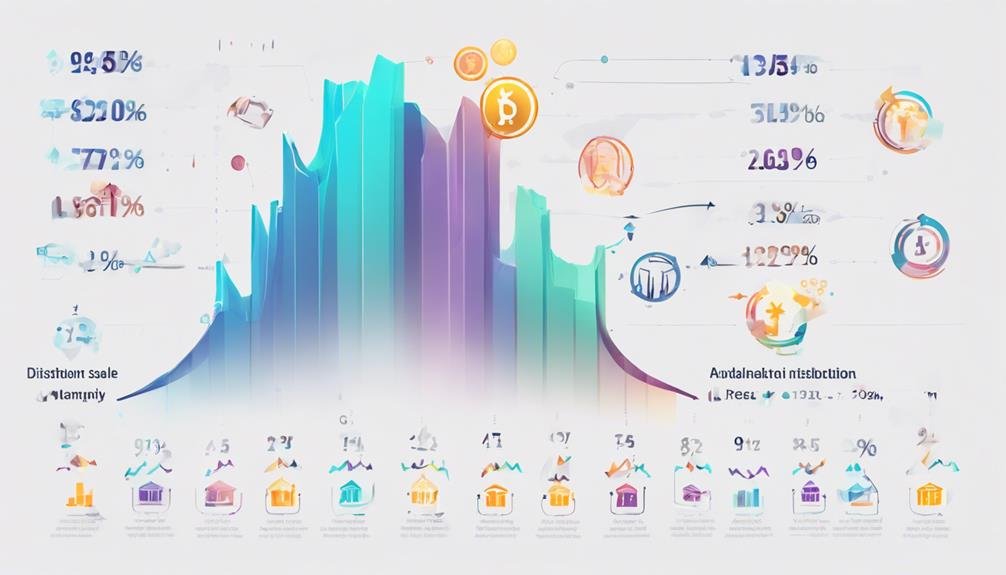To thrive in DeFi, utilize Airdrop Campaigns for token distribution and community engagement. Pre-sale events offer early access and funding. Public Sale Initiatives reach more investors. Liquidity Mining Programs boost engagement and platform liquidity. Staking Rewards Systems incentivize network participation and governance. Token Burn Mechanisms shape supply and demand dynamics.
Community Incentive Programs foster loyalty and participation. These strategies are crucial for success, enhancing visibility, and project development. Each strategy plays a unique role in expanding DeFi projects. An integrated approach to token distribution is essential for sustainable growth and success in the evolving DeFi landscape.
Brief Overview of Defi Token Distribution Strategies For Growth
- Airdrop campaigns for free token distribution and community engagement.
- Pre-sale events offer early access, discounts, and scarcity.
- Public sale initiatives engage investors and foster community growth.
- Liquidity mining programs incentivize user participation and platform liquidity.
- Staking rewards systems offering passive income and governance rights.
Airdrop Campaigns
A well-planned airdrop campaign can serve as a strategic tool in distributing free tokens to holders of specific cryptocurrencies for promotional purposes. These campaigns are essential components of token distribution models, aiming to increase token awareness, incentivize community engagement, and attract new users. By distributing tokens through airdrops, projects can create a buzz, generate interest, and potentially boost token value. Additionally, governance tokens distributed through airdrops can empower token holders to participate in project decision-making processes, enhancing community involvement and fostering a sense of ownership.
Successful airdrop campaigns have proven effective in driving user growth and increasing token liquidity. When executed correctly, an airdrop can drive token adoption, enhance project visibility, and establish a loyal community base. The strategic allocation of tokens through airdrops can play an important role in the growth and sustainability of decentralized finance projects.
Pre-Sale Events

Upon concluding successful airdrop campaigns, decentralized finance projects often proceed to engage potential investors through pre-sale events, offering exclusive opportunities for early access to tokens. These events aim to attract early adopters and supporters by allowing them to acquire tokens before the public sale. Incentives such as discounted token prices or exclusive bonuses are commonly offered during pre-sale events to encourage participation.
Beyond attracting investors, pre-sale events raise initial funding for the project’s development and marketing efforts. The limited token supply available during pre-sale events can create a sense of scarcity, driving up demand among investors. Additionally, transparent and well-structured pre-sale events are vital in enhancing the project’s credibility and building trust within the community. Overall, pre-sale events represent a strategic approach for token distribution that sets the foundation for a project’s growth and success in the decentralized finance space.
Public Sale Initiatives

Engaging a broader audience of investors, public sale initiatives play a pivotal role in increasing project visibility and fostering community engagement within the decentralized finance ecosystem. Setting an appropriate token price during public sales is essential as it can attract more investors and guarantee a fair distribution of tokens. By offering tokens to a wider range of participants, projects can generate the necessary funding for development and expansion, contributing to their long-term sustainability. Additionally, a transparent and well-structured public sale process enhances investor trust and confidence in the project, laying a solid foundation for future growth.
Strategically timing public sales to coincide with market trends and demand can maximize the effectiveness of token distribution, leading to broader participation and increased project exposure. Public sale initiatives serve as a fundamental strategy for DeFi projects to reach a diverse investor base, raise capital, and establish a supportive community for sustainable development in the decentralized finance space.
Liquidity Mining Programs

Implementing Liquidity Mining Programs is a common strategy in decentralized finance to incentivize user participation and enhance platform liquidity. These programs incentivize users to provide liquidity to DeFi platforms by rewarding them with additional tokens. By participating in liquidity mining, users, also known as yield farmers, can strategically allocate their assets to different pools to maximize their returns.
Not only does liquidity mining benefit individual participants, but it also plays a vital role in boosting platform liquidity and fostering active engagement within the DeFi ecosystem. Prominent DeFi platforms like Uniswap and SushiSwap have leveraged liquidity mining programs to attract users and build a vibrant community around their protocols. As the DeFi space evolves, liquidity mining will likely remain a fundamental strategy for driving growth and incentivizing user involvement in decentralized finance platforms.
Staking Rewards Systems

Staking rewards systems are vital in incentivizing token holders to actively participate in network activities. These systems offer rewards in the form of additional tokens for holders who commit their assets to support network functions. By engaging in staking, users can not only earn passive income but also gain voting rights in governance decisions, impacting the future direction of the network.
Staking Benefits and Risks
Participating in staking rewards systems allows token holders to actively contribute to network security while earning passive income in the form of additional tokens. Staking benefits and risks include:
- Passive Income: Staking offers a way to earn rewards through interest or additional tokens.
- Network Security: Token holders help secure the network by participating in validation or governance activities.
- Varied Rewards: Staking rewards differ based on consensus mechanisms and staking duration.
- Slashing Risks: There are penalties for malicious behavior, potentially leading to the loss of staked tokens.
- Network Stability: Staking carries risks related to network instability, requiring careful consideration before participation.
Token Lock-Up Periods
An essential component of staking rewards systems in decentralized finance (DeFi) projects is the establishment of token lock-up periods. These periods incentivize long-term holding by restricting access to tokens encouraging token holders to participate in staking rewards programs. Longer lock-up periods often lead to higher staking rewards, fostering sustained commitment and reducing tokens’ circulating supply.
This mechanism aids in stabilizing token prices by balancing supply and demand dynamics. Additionally, token lock-up periods and staking rewards systems play an important role in enhancing network security and community engagement in governance activities. By engaging users in these processes, projects can foster a sense of ownership and involvement, contributing to the overall growth and sustainability of the DeFi ecosystem.
Governance Voting Rights
Enhancing decentralized governance within DeFi projects, token holders who engage in staking activities are granted valuable voting rights based on their staked token amounts. Staking reward systems are important in incentivizing active participation in network security and decision-making processes. Here are key points to bear in mind:
- Staking rewards provide governance voting rights proportional to the tokens staked.
- Token holders earn rewards for securing the blockchain and participating in network activities.
- Incentivizing long-term commitment and staking rewards encourage community engagement.
- Governance voting empowers stakeholders to influence protocol upgrades and key decisions.
- Stocking rewards systems enhance decentralization, security, and engagement within DeFi projects.
Token Burn Mechanisms

Token burn mechanisms play a vital role in altering the circulating supply of a token. By reducing the number of tokens in circulation, scarcity may rise, potentially driving up demand. The benefits of token burn strategies warrant an analysis of burn rates and their efficiency.
Burn Rate Impact
How does implementing token burn mechanisms impact tokens’ overall circulation and value within decentralized finance projects? Token burns are essential in shaping the dynamics of a project’s token economy. Here are some key points to take into account:
- Token burn mechanisms reduce the total supply of tokens, increasing scarcity.
- The scarcity created by burning tokens can drive up the value of the remaining tokens.
- Projects often use token burns to reward long-term holders and create deflationary pressure.
- Token burns can be scheduled or triggered by specific actions, such as transaction fees.
- The impact of token burns on the token’s price and market dynamics is closely monitored by investors and analysts.
Burning Efficiency Analysis
The analysis of burning efficiency in DeFi projects’ token burn mechanisms involves evaluating the impact on token supply, demand, and market dynamics, shedding light on the effectiveness of these strategic actions. Token burning, a common practice in DeFi, aims to increase scarcity and boost the value of the remaining tokens. By permanently removing a portion of tokens from circulation, projects can align incentives and reward holders and uphold the token value.
Whether scheduled or triggered by specific events, such as achieving milestones or network upgrades, these burns play an important role in shaping the token’s ecosystem. Understanding how token burns influence supply and demand dynamics is essential for gauging their impact on the token value and market conditions.
Benefits of Token Burn
One of the key advantages of implementing token burn mechanisms in DeFi projects is the strategic reduction of the total token supply, fostering scarcity and potentially elevating the token’s market value.
- Token burn decreases the circulating supply, boosting scarcity.
- Long-term holders may benefit as the supply diminishes over time.
- Public announcements guarantee community awareness and process transparency.
- Decisions to burn tokens are often based on preset criteria or strategic needs.
- Token Burn aligns the token’s value with project growth and development goals.
Community Incentive Programs

Engaging users through community incentive programs is a key strategy for fostering active participation in decentralized finance projects. These programs offer rewards, such as airdrops, staking rewards, and referral bonuses, to users for engaging in project activities. By incentivizing community engagement, projects can enhance visibility and cultivate user loyalty within the ecosystem of digital assets. Rewards distributed through these programs can take various forms, including tokens, exclusive access, or discounts, providing users with tangible benefits for their involvement.
Well-designed community incentive programs play an important role in driving community growth and ultimately contributing to the success of decentralized finance projects. They encourage users to actively participate in project activities, creating a more vibrant and engaged community. By offering incentives that align with users’ interests and motivations, projects can effectively stimulate user engagement and foster a sense of belonging within the community.
Frequently Asked Questions
What Are the Yield Strategies in Defi?
Yield strategies in DeFi involve maximizing returns through various methods like yield farming and liquidity mining. Users can earn interest or governance tokens by participating in decentralized finance protocols, providing liquidity, and staking assets.
What Are the Models of Token Distribution?
Key factors like fair distribution, airdrop campaigns, liquidity mining, and staking rewards play pivotal roles when considering token distribution models. Various strategies are employed to allocate tokens effectively and sustain growth within the project.
How Do You Market a Defi Project?
To market a DeFi project effectively, prioritize community engagement, leverage influencer partnerships, run targeted social media campaigns, and implement airdrop promotions. Building trust and credibility through transparent communication and regular updates is key to success.
What Are the Top 5 Decentralized Coins?
Decentralized coins like Astar, Sei, and dYdX are top performers in the market, showcasing strong growth potential and innovative features. Market analysis indicates a promising trajectory for these tokens, reflecting the evolving DeFi landscape.
Conclusion
In summary, the distribution strategies for DeFi tokens play a pivotal role in the growth and success of a project. By implementing a mix of airdrops, pre-sale events, public sale initiatives, liquidity mining programs, staking rewards systems, token burn mechanisms, and community incentive programs, projects can attract and retain a strong user base. As the saying goes, ‘The early bird catches the worm,’ early adoption of innovative token distribution strategies can lead to long-term success in the competitive DeFi space.










